
|
|
FYBUSH.COM/SITE OF THE WEEK
NEEDS YOUR SUPPORT! (AND YOU CAN GET A FREE TOWER SITE CALENDAR
IF YOU PLEDGE NOW...) CLICK HERE
TO LEARN MORE...
October 15-22, 2004
Chicago's Legendary WLS: Part II, The Transmitter
One of the really neat things about doing this website and the Tower Site Calendar - not to mention writing for great publications such as Radio World - is the way it opens doors to radio places that most people don't ever get to see, including a lot of nifty transmitter sites. Each one is special in its own way, but over the years, I've taken a particular fancy to the former class I-A clear channel stations. These 25 stations each had the privilege, once upon a time, of being the only North American nighttime signal on their frequencies, and even today they remain the kings of the increasingly crowded AM dial . In a decade (and then some) of intensive radio travel, I've seen 22 of the 25 from the outside (gotta get to Minneapolis, San Antonio and Salt Lake City) and have had the honor of touring seven of them.
July 2004 found me at one of those seven, the mighty WLS (890 Chicago), and what a neat site it is!
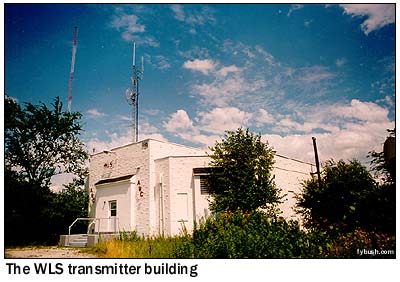
|
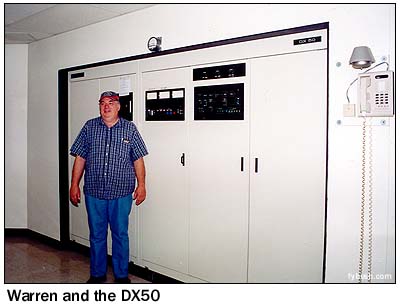
|
The WLS site is a very long way from the rest of Chicago's big AM signals. WGN, WBBM and WSCR (the old WMAQ) are all located west and a little north of town, a pretty central spot from which to hit the whole market. But WLS is way down in Tinley Park, astride I-80 just east of its intersection with US 45, a good 25 miles southwest of the Loop. Why the remote locale? Seems that way back in 1938, when the site was built, the then-owners of WLS (the Prairie Farmer magazine) had a tax grudge going with Cook County - so they deliberately sited their transmitter on a piece of land that abutted, but didn't quite enter, Cook County. Now you know.
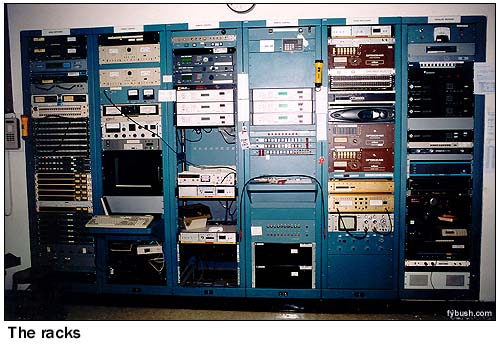 (Putting
the transmitter south of town had a side effect as well - WLS
gets out somewhat better than its other Chicago counterparts
into the agricultural heartland of Illinois, blanketing places
like Champaign-Urbana, Springfield and Peoria. For the Prairie
Farmer, that was quite desirable back then; it was probably
not a bad thing for NBC, either, which operated the other half
of the frequency as Blue Network outlet WENR.)
(Putting
the transmitter south of town had a side effect as well - WLS
gets out somewhat better than its other Chicago counterparts
into the agricultural heartland of Illinois, blanketing places
like Champaign-Urbana, Springfield and Peoria. For the Prairie
Farmer, that was quite desirable back then; it was probably
not a bad thing for NBC, either, which operated the other half
of the frequency as Blue Network outlet WENR.)
The building's somewhat unusual, too - how many octagonal transmitter buildings do you see out there? (Answer: very, very few.)
We've stitched together two photos at the top of the page to give you a sense of what you see when you walk in the door.
Out of frame to the left is the engineering office (complete, we're pleased to note, with a Tower Site Calendar hanging on the wall); to the right is the bathroom and an entrance to the back rooms that wrap around the main transmitter room.
At the left of the panorama (and above, with CE Warren Shulz posing in front) is the current main transmitter, a Harris DX50. Next to that is a Continental 317C3, in active use as a backup transmitter.
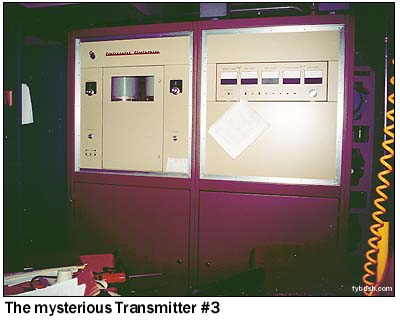 Look
carefully in the big rack at the center of the room, though,
and you'll see three of a lot of things - transmitter
remote controls, audio processors and such. What's that all about?
Go into the room behind the racks and you'll find the answer:
another Continental transmitter, this one just five kilowatts,
that's kept in working order but is deliberately left unconnected
to power. Here's the theory: any damage serious enough to require
the use of transmitter three would also be serious enough to
get an engineer out to the site to make the needed connections
to hook the 5 kW unit to a power source (probably the generator)
and to the antenna system - and in the meantime, the transmitter
would be protected from any damage that might occur from, say,
a lightning hit to the incoming power feeds or the tower.
Look
carefully in the big rack at the center of the room, though,
and you'll see three of a lot of things - transmitter
remote controls, audio processors and such. What's that all about?
Go into the room behind the racks and you'll find the answer:
another Continental transmitter, this one just five kilowatts,
that's kept in working order but is deliberately left unconnected
to power. Here's the theory: any damage serious enough to require
the use of transmitter three would also be serious enough to
get an engineer out to the site to make the needed connections
to hook the 5 kW unit to a power source (probably the generator)
and to the antenna system - and in the meantime, the transmitter
would be protected from any damage that might occur from, say,
a lightning hit to the incoming power feeds or the tower.
Clever - and good planning, too, isn't it?
WLS chief engineer Warren Shulz is a major proponent of good emergency planning (he's one of the national planners of the EAS system, in fact), so it's no surprise to head downstairs and find that everything's in place to keep the station on the air indefinitely in case of emergency - a room that can be used as a studio, plenty of generator capacity, you name it. (In other words, don't expect to hear WLS off the air any time soon.)
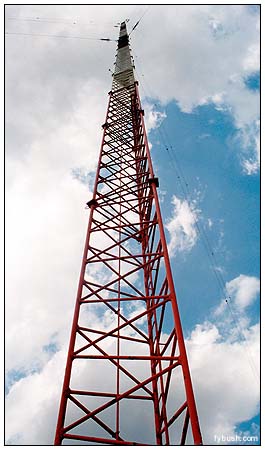 And
like any good I-A clear channel, there are of course two towers
here - the 586-foot big guy and a much shorter auxiliary tower
that can be pressed into service in an emergency.
And
like any good I-A clear channel, there are of course two towers
here - the 586-foot big guy and a much shorter auxiliary tower
that can be pressed into service in an emergency.
It's rather a long walk back into the field behind the transmitter building to reach the big tower, but it's well worth it just to gaze up this venerable Blaw-Knox stick (yes, they built standard guyed towers in addition to the distinctive diamond-shaped towers) and to think about all the amazing radio that emanated from this piece of steel over the many years of "Musicradio 89" and the many formats that came before and after.
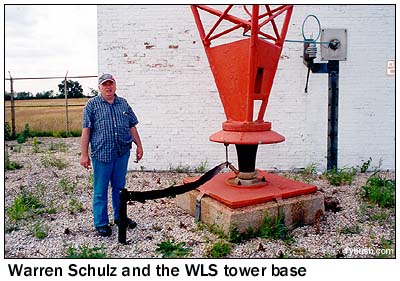 See
that slot in the base of the tower, just above the flange that
sits atop the insulator? Those Blaw-Knox guys knew what they
were doing - or at least that ceramic insulators don't last forever.
See
that slot in the base of the tower, just above the flange that
sits atop the insulator? Those Blaw-Knox guys knew what they
were doing - or at least that ceramic insulators don't last forever.
It turns out that the slot is designed to have a steel bar inserted through it, which can then be jacked up to take the tower's weight off the insulator - and indeed, that's just what WLS had to do some years back. (One glance at the base of that tower and you can see that there's no way that's a 1938-vintage insulator, after all.)
So that's our look inside WLS - and our return to weekly Tower Sites for the new fall season. We've got a lot to show you, including a whole bunch of new Los Angeles images from our just-concluded trip out to the NAB Radio Show...so stay tuned, buy a calendar (or two or three) to show your support, and we'll see you back here next week!
 It's here - the
2005 Tower Site Calendar is now shipping! Click
here for ordering information!
It's here - the
2005 Tower Site Calendar is now shipping! Click
here for ordering information!
- Previous Site of the Week: WLS, part I: The Studio
- Next Week: New York's WBBR 1130
- Site of the Week INDEX!
- How can you help support Site of the Week? Click here!
- Submit your suggestions for a future Site of the Week!
